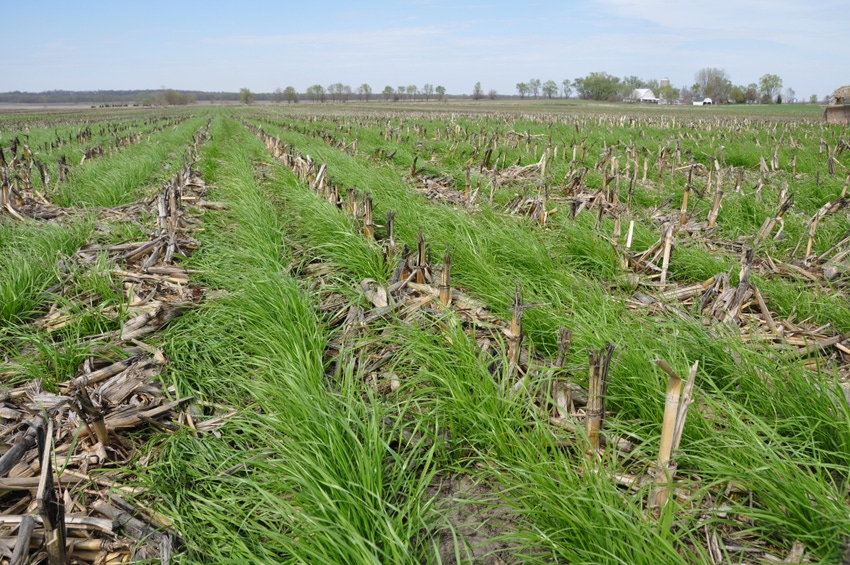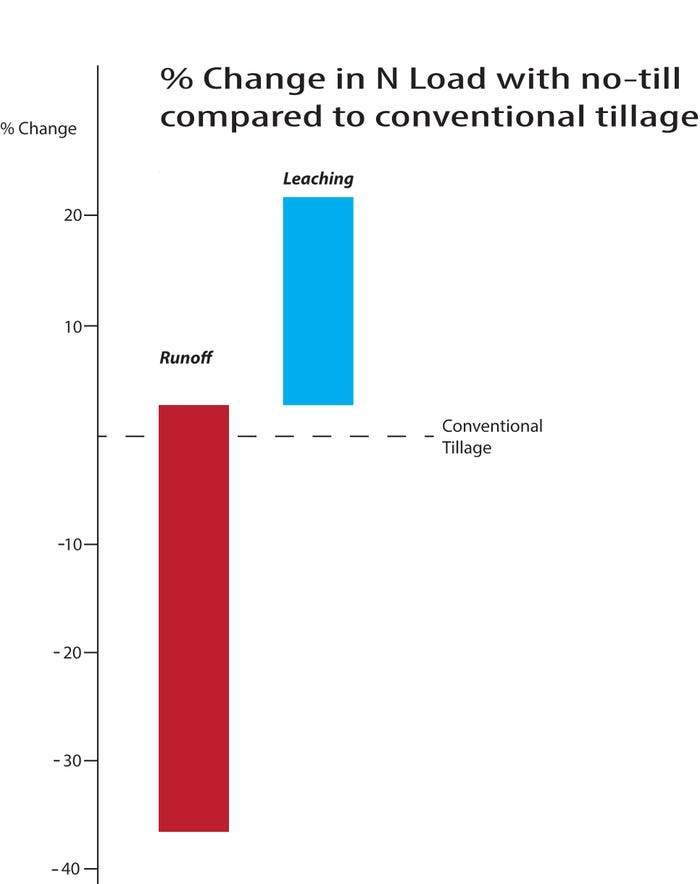October 5, 2018

Think Different.
Conservation practices like no-till that save soil are also good for water quality, right? In many ways that’s true, but not in the case of nitrates and no-till. In fact, largely because no-till increases infiltration—a good thing for reducing erosion and runoff—nitrate losses through underground leaching are higher with no-till than with conventional tillage.
However, cover crops, intercropping, crop rotations with use of perennial crops, reduced and split nitrogen applications, and injection of fertilizer are options to improve nitrogen use efficiency and reduce nitrate loss from crop fields.
---------------
No-till farming has a proven track record as a practice that cuts soil erosion substantially, but it doesn’t enjoy the same success in reducing nitrate loss from crop fields to streams and lakes. In fact, while research results over the past 30 years have been highly variable, overall, no-till contributes to higher nitrate losses than conventional tillage, according to a meta-analysis by researchers at Indiana University Purdue University Indianapolis (IUPUI).
“Our analysis shows nitrate load reductions in some instances where no-till reduces runoff, but overall—primarily because of nitrate leaching—no-till resulted in higher NO3 (nitrate) loss than conventional tillage,” says Pierre-André Jacinthe, one of three researchers at IUPUI who compared reported nitrate concentration and loads from paired no-till and conventionally tilled research projects across various field conditions.
“To learn how effective no-till has been in reducing nitrates in water leaving croplands, we built a database from published research from 1985 to 2016, comparing no-till with conventional tillage on corn, soybean and wheat fields,” says Stefani Daryanto, a postdoctoral researcher who led the statistical analysis along with professor Lixin Wang. “We compiled information on 337 data points from 43 studies on nitrate concentrations, and 241 data points from 33 studies on nitrate loads. We analyzed reported nitrate losses from both runoff and leached nitrate from varying rainfall, aridity, soil texture, no-till duration, crop species and types of fertilizer—and found that overall, no-till provided no reduction in nitrate concentrations or load in comparison to conventional tillage.”

The change in nitrate loading in runoff from conventional tillage to no-till ranged from a slight increase to as much as a 35% reduction. Loading from leaching, though, was shown to increase with no-till by a range of about 3 to 22%.
Conventional tillage included chisel plowing, field cultivating, disking, and other tillage methods. No-till farming was defined as zero tillage in the analysis.
Leaching a major pathway
“Overall, research shows no-till resulted in runoff loads of nitrate similar to conventional tillage, but nitrate concentration in runoff from no-till fields was higher,” Jacinthe says. “In contrast, nitrate loads from leaching through no-till fields were higher than conventionally tilled fields, with similar concentrations of nitrate in both systems. What’s concerning is the nitrate loads in water that leaches through the soil and enters underground drainage tile. That’s the major pathway to nitrate loss on no-till fields compared to conventionally tilled fields.”
Jacinthe says more crop residues and a build-up of macropores under no-till result in more water infiltrating into the soil. Increased infiltration reduces runoff and nitrate load in water runoff, but since that water infiltrates into the ground, it results in a higher volume of leached nitrate in underground water.
Variability by year, soil, weather
The compiled research shows nitrate loads and concentrations varied by soils, weather, and other field conditions. Specifically, the analysis shows that in comparison to conventional tillage, no-till:
generated higher runoff nitrate concentration in both wet and dry years; in both dryland and non-dryland soils; and in all textures of soil.
produced lower nitrate concentrations through leaching during wet and normal years, and in coarse-textured and non-dryland soils.
produced higher concentrations of nitrate in runoff in fields with long-range no-till duration (more than 10 years) and in fields with nitrogen fertilizer use.
Produced increased nitrate concentrations via leaching in drylands.
Long-term no-till
Nitrate concentrations in runoff from fields in no-till for only a few years were similar to conventionally tilled fields, but in fields that had been in no-till more than 10 years, concentration of nitrates was higher. Nitrate loads in runoff, on the other hand, were similar to conventional tillage regardless of how long the field had been in no-till.
“In contrast, the nitrate load loss through leaching increased compared to conventional tillage regardless of no-till duration, or whether it was in a corn or wheat field or whether it was fertilized,” Jacinthe says, “and under long-range no-till, there was a significantly higher nitrate load through leaching. The only case where no-till produced nitrate loading through leaching that was similar to conventional tillage was in a soybean field with no fertilization. Interestingly, we didn’t find the type of fertilizer made any significant difference in the concentration of nitrates in either runoff or leaching.”

A meta-analysis showed nitrate concentration in no-till runoff was much as 35% higher than with conventional tillage systems, but nitrate concentration through leaching was similar with both systems.
The drainage difference
In well-drained soils—those that don’t need or use artificial drainage—researchers found no difference in nitrate runoff concentration, as well as a reduced runoff load with no-till compared to conventional tillage. However, the higher nitrate loads that resulted from leaching in poorly drained and clay-rich soils were further exacerbated by tile drains. “When tile drainage does its intended job to move water out of the soil more quickly, an unintended consequence is it short-cuts the natural water flow through the soil matrix, contributing to higher loads of nitrate in water that leaves the field,” Jacinthe says.
Combine no-till with other practices
The soil erosion control, soil organic matter buildup, structure stability, better water infiltration and favorable crop growing conditions that come with no-till contribute to higher water flux and create higher nitrate loading through leaching. That creates a tradeoff between the advantages of no-till and the downside of higher nitrate levels in water, Jacinthe says.
“Healthy soils have good water and air movement through them, and no-till helps with that,” says Jacinthe. “Unfortunately, that means more nitrates leach through the soil through macropores that become major pathways for nitrate loss into the water. It points to the need to use other practices with no-till.”
Jacinthe says cover crops, intercropping, crop rotations with use of perennial crops, reduced and split nitrogen applications, and injection of fertilizer are options to improve nitrogen use efficiency and reduce nitrate loss from crop fields.
Note: Research noted in this story was completed by:
Dr. Pierre-André Jacinthe, Professor and Director of the Center for Earth and Environmental Sciences at IUPUI; Dr. Lixin Wang, Assistant Professor, Department of Earth Sciences at IUPUI; and Dr. Stefani Daryanto, postdoctoral researcher, Department of Earth Sciences at IUPUI.
About the Author(s)
You May Also Like




